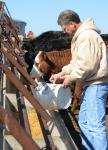COLUMBIA, Mo. – “Buyer beware” when purchasing carryover soybean seed from online sites, advises University of Missouri Extension soybean specialist Bill Wiebold.
“Why put your whole crop next year at risk to save a few dollars? It’s foolish economy. You get what you pay for,” he says.
Although it’s cheap, risks outweigh savings.
There are no guarantees with saved seed or seed purchased independently, Wiebold says. He recommends working with a trusted seed dealer. Seed sold legally in Missouri must possess a tag listing weed seed, inert matter and germination percentage. More importantly, most seed dealers have a full or partial replacement plan if replanting is necessary.
With about 20 percent of Missouri’s intended soybean crop unplanted, farmers face decisions on what to do with seed they purchased but were unable to plant.
Previous generations of farmers stored seed to use the next year. Wiebold does not recommend this practice.
“When farmers saved soybean seed for planting, they harvested in the fall and planted in the spring. They stored seed through late fall, winter and early spring. Weather conditions were relatively cool during most of the storage period,” he says.
Seed not used in 2015 must be stored through this summer. It was already stored through fall, winter and spring and has aged somewhat.
“If saved for planting in 2016, seed would be stored for an additional fall, winter and spring, which by itself doubles the aging time,” Wiebold says. “And it would be stored through the hot, humid summer months.”
On-farm storage also may provide less than ideal conditions with storage temperatures often above air temperatures.
Present-day farmers use lower seeding rates and plant earlier in the season. The stress of earlier planting cuts germination rates and results in lower yields and profits from low-quality seeds.
If you save seed to plant next year, Wiebold recommends four things: Keep it dry, keep it cool, keep it in low humidity storage, and pay for a vigor test. Temperature and moisture are enemies of stored seed, he says. As temperature and humidity rise, the risk of vigor loss increases.
You can’t see seed quality loss by looking at seed. Standard warm germination tests evaluate viability and accelerated aging (AA) tests determine seed vigor. Wiebold recommends both tests for stored seed.
The Missouri Crop Improvement Association, the state’s official seed certifying agency, offers standard germination and AA tests. Richard Arnett, executive director, recommends that soybean producers send 8 ounces of seed from different areas of their soybean in storage in late March to mid-April for testing.
Producers can evaluate results of both tests to determine “suitability of when and where you should plant,” Arnett says.
Test results in the fall or winter may vary from results at planting time. “We don’t plant in optimum conditions,” Wiebold says. Risks increase with early planting and pressure from disease and insects.
Some experts recommend storing at 51 degrees and 60 percent relative humidity, or in warm storage at 78 degrees and 31 percent humidity. If storage temperature increases, then humidity must decrease to protect seed quality. That is difficult to do in on-farm storage, Wiebold says.
Farmers may want to use leftover seed as a cover crop, he says. Plant it on fallow ground or as a food plot for wildlife.
Leftover soybean seed is “free seed” that grows well in August. The plant dies when it frosts but still provides ground cover to prevent erosion.
For more information, contact the Missouri Crop Improvement Association, 3211 Lemone Industrial Blvd., Columbia, MO 65201, or call 573-449-0586.
Read more http://extension.missouri.edu/news/DisplayStory.aspx?N=2602





